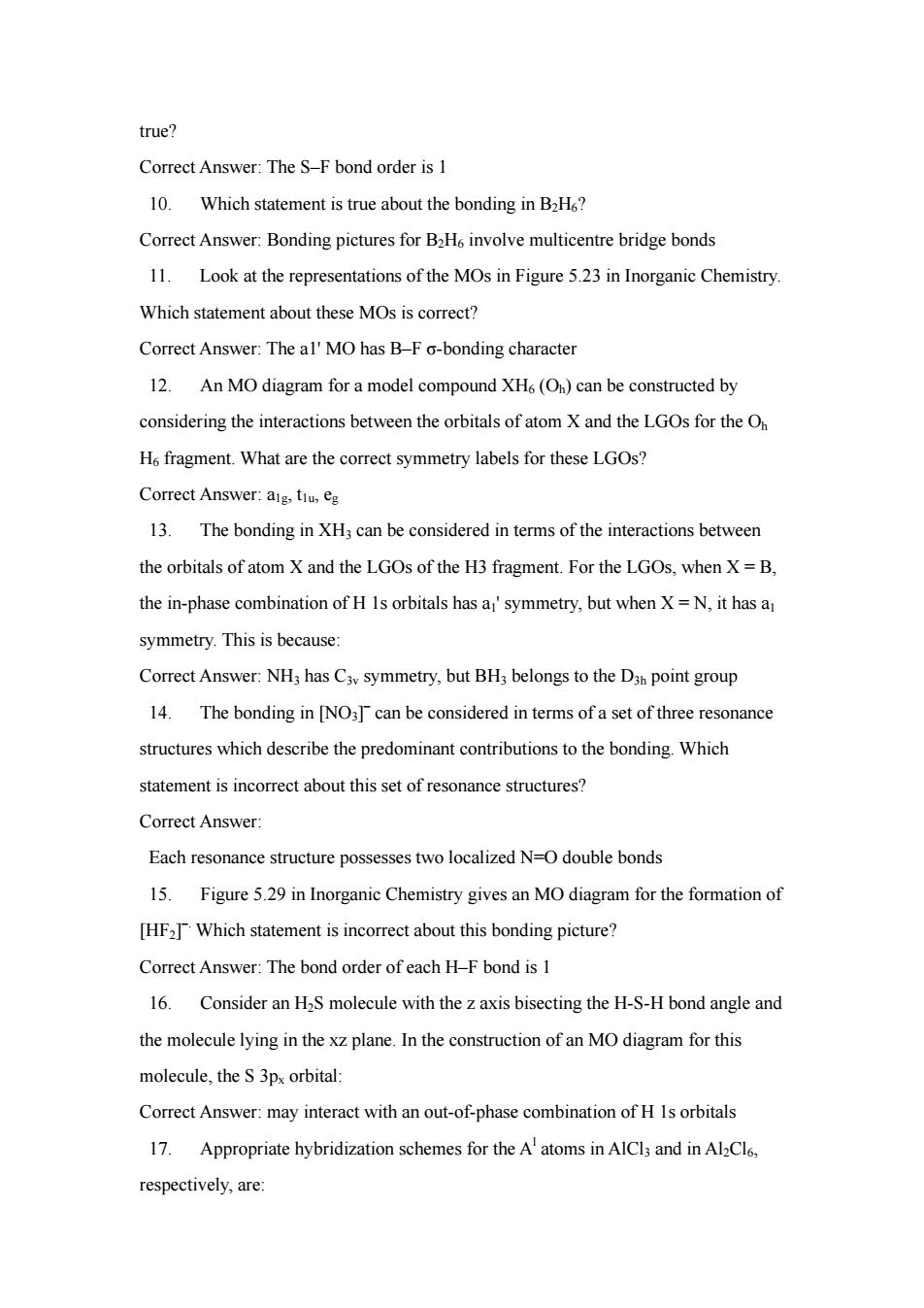
true? Correct Answer:The S-F bond order is 1 10.Which statement is true about the bonding in B2H? Correct Answer:Bonding pictures for B2H involve multicentre bridge bonds 11.Look at the representations of the MOs in Figure 5.23 in Inorganic Chemistry. Which statement about these MOs is correct? Correct Answer:The al'MO has B-F a-bonding character 12.An MO diagram for a model compound XH(On)can be constructed by considering the interactions between the orbitals of atom X and the LGOs for theO H fragment.What are the correct symmetry labels for these LGOs? Correct Answer:aig, 13.The bonding in XH3 can be considered in terms of the interactions between the orbitals of atom X and the LGOs of the H3 fragment.For the LGOs,when X=B, the in-phase combination of H Is orbitals has a'symmetry,but when X=N,it has a symmetry.This is because: Correct Answer:NH,has C3 symmetry,but BH,belongs to the D3h point group 14.The bonding in [NO can be considered in terms of a set of three resonance structures which describe the predominant conributions to the bonding.Which statement is incorrect about this set of resonance structures? Correct Answer: Each resonance structure possesses two localized N-double bonds 15.Figure 5.29 in Inorganic Chemistry gives an MO diagram for the formation of [HFWhich statement is incorrect about this bonding picture? Correct Answer:The bond order of each H-F bond is I 16.Consider an H2S molecule with the z axis bisecting the H-S-H bond angle and the molecule lying in the xz plane.In the construction of an MO diagram for this molecule,the S3px orbital: Correct Answer:may interact with an out-of-phase combination of H Is orbitals 17.Appropriate hybridization schemes for the A'atoms in AlCls and in AlzCl respectively,are
true? Correct Answer: The S–F bond order is 1 10. Which statement is true about the bonding in B2H6? Correct Answer: Bonding pictures for B2H6 involve multicentre bridge bonds 11. Look at the representations of the MOs in Figure 5.23 in Inorganic Chemistry. Which statement about these MOs is correct? Correct Answer: The a1' MO has B–F σ-bonding character 12. An MO diagram for a model compound XH6 (Oh) can be constructed by considering the interactions between the orbitals of atom X and the LGOs for the Oh H6 fragment. What are the correct symmetry labels for these LGOs? Correct Answer: a1g, t1u, eg 13. The bonding in XH3 can be considered in terms of the interactions between the orbitals of atom X and the LGOs of the H3 fragment. For the LGOs, when X = B, the in-phase combination of H 1s orbitals has a1' symmetry, but when X = N, it has a1 symmetry. This is because: Correct Answer: NH3 has C3v symmetry, but BH3 belongs to the D3h point group 14. The bonding in [NO3] – can be considered in terms of a set of three resonance structures which describe the predominant contributions to the bonding. Which statement is incorrect about this set of resonance structures? Correct Answer: Each resonance structure possesses two localized N=O double bonds 15. Figure 5.29 in Inorganic Chemistry gives an MO diagram for the formation of [HF2] –. Which statement is incorrect about this bonding picture? Correct Answer: The bond order of each H–F bond is 1 16. Consider an H2S molecule with the z axis bisecting the H-S-H bond angle and the molecule lying in the xz plane. In the construction of an MO diagram for this molecule, the S 3px orbital: Correct Answer: may interact with an out-of-phase combination of H 1s orbitals 17. Appropriate hybridization schemes for the Al atoms in AlCl3 and in Al2Cl6, respectively, are:
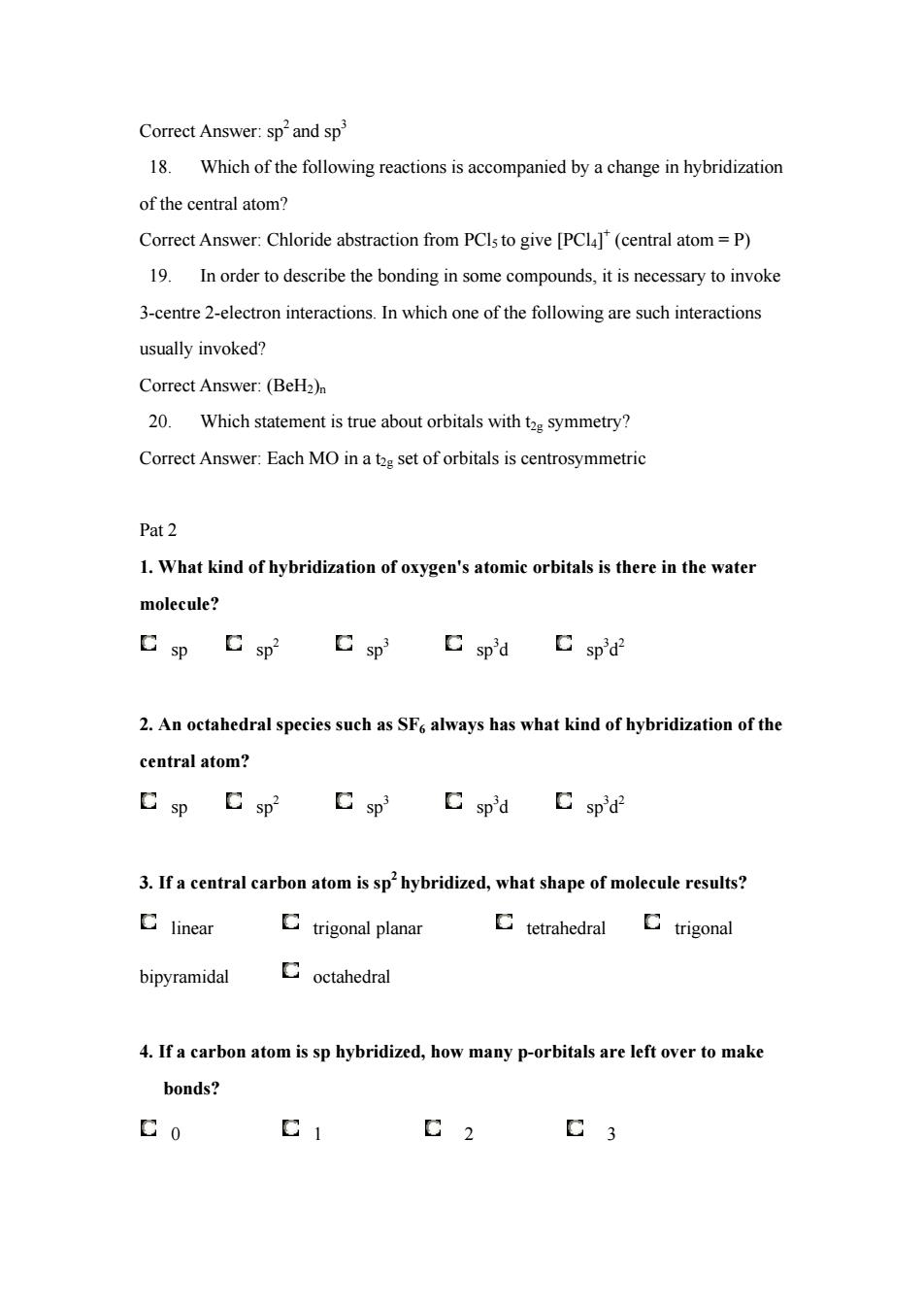
Correct Answer:sp2and sp' 18.Which of the following reactions is accompanied by a change in hybridization of the central atom? Correct Answer:Chloride abstraction from PCls to give [PCl](central atom=P) 19.In order to describe the bonding in some compounds,it is necessary to invoke 3-centre 2-electron interactions.In which one of the following are such interactions usually invoked? Correct Answer:(BeH2)n 20.Which statement is true about orbitals with ta symmetry? Correct Answer:Each MO in atset of orbitals is centrosymmetric Pat2 1.What kind of hybridization of oxygen's atomic orbitals is there in the water molecule? C sp C spsp sp'd C sp'd? 2.An octahedral species such as SF always has what kind of hybridization of the central atom? C sp C sp sp C sp'd sp'd 3.If a central carbon atom is sphybridized,what shape of molecule results? C linear trigonal planar bipyramidal Coctahedral 4.If a carbon atom is sp hybridized,how many p-orbitals are left over to make bonds? 00 01 02 03
Correct Answer: sp2 and sp3 18. Which of the following reactions is accompanied by a change in hybridization of the central atom? Correct Answer: Chloride abstraction from PCl5 to give [PCl4] + (central atom = P) 19. In order to describe the bonding in some compounds, it is necessary to invoke 3-centre 2-electron interactions. In which one of the following are such interactions usually invoked? Correct Answer: (BeH2)n 20. Which statement is true about orbitals with t2g symmetry? Correct Answer: Each MO in a t2g set of orbitals is centrosymmetric Pat 2 1. What kind of hybridization of oxygen's atomic orbitals is there in the water molecule? sp sp 2 sp3 sp3 d sp3 d2 2. An octahedral species such as SF6 always has what kind of hybridization of the central atom? sp sp2 sp3 sp3 d sp3 d2 3. If a central carbon atom is sp2 hybridized, what shape of molecule results? linear trigonal planar tetrahedral trigonal bipyramidal octahedral 4. If a carbon atom is sp hybridized, how many p-orbitals are left over to make bonds? 0 1 2 3
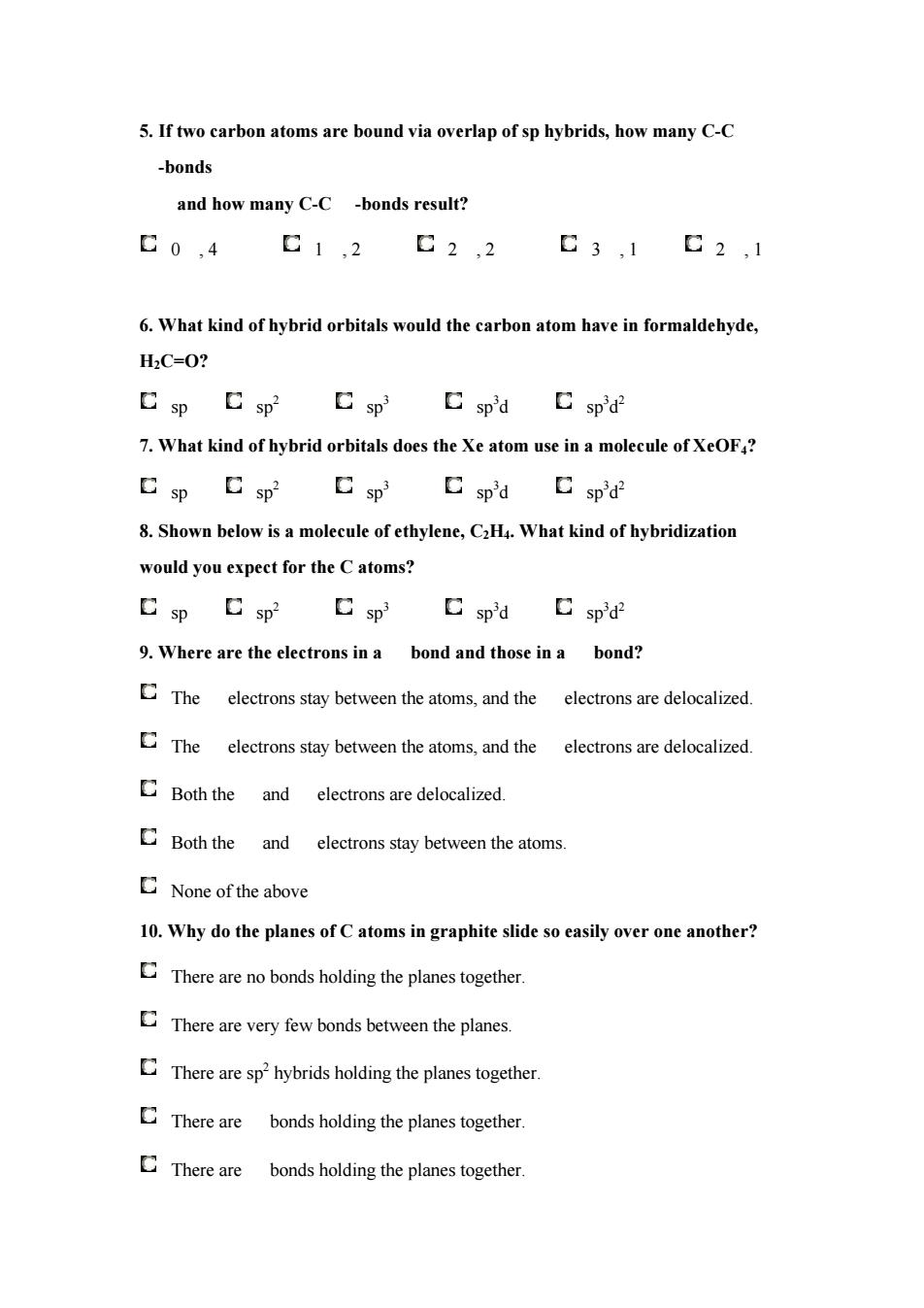
5.If two carbon atoms are bound via overlap of sp hybrids,how many C-C -bonds and how many C-C -bonds result? C0,4口1,2口2,203,1口2,1 6.What kind of hybrid orbitals would the carbon atom have in formaldehyde, H2C=0? Csp口sp2 C sp C sp'd C sp'd 7.What kind of hybrid orbitals does the Xe atom use in a molecule of XeOF? C sp C spsp C sp'd C sp'd? 8.Shown below is a molecule of ethylene,C2H.What kind of hybridization would you expect for the C atoms? sp E sp:E sp C sp'd C sp'd 9.Where are the electrons in a bond and those in a bond? The eletros stay between the atoms,and the elctros are delocalized. The to stay between the atoms,and the oare delcalized. Both the and electrons are delocalized Both the and electros stay between the atoms. None of the above 10.Why do the planes of C atoms in graphite slide so easily over one another? Thereareo bonds holding the planes toether. There are very few bonds between the planes. There holding the planes together There are bonds holding the planes together. There are bonds holding the planes together
5. If two carbon atoms are bound via overlap of sp hybrids, how many C-C -bonds and how many C-C -bonds result? 0 , 4 1 , 2 2 , 2 3 , 1 2 , 1 6. What kind of hybrid orbitals would the carbon atom have in formaldehyde, H2C=O? sp sp 2 sp3 sp3 d sp3 d2 7. What kind of hybrid orbitals does the Xe atom use in a molecule of XeOF4? sp sp 2 sp3 sp3 d sp3 d2 8. Shown below is a molecule of ethylene, C2H4. What kind of hybridization would you expect for the C atoms? sp sp 2 sp3 sp3 d sp3 d2 9. Where are the electrons in a bond and those in a bond? The electrons stay between the atoms, and the electrons are delocalized. The electrons stay between the atoms, and the electrons are delocalized. Both the and electrons are delocalized. Both the and electrons stay between the atoms. None of the above 10. Why do the planes of C atoms in graphite slide so easily over one another? There are no bonds holding the planes together. There are very few bonds between the planes. There are sp2 hybrids holding the planes together. There are bonds holding the planes together. There are bonds holding the planes together
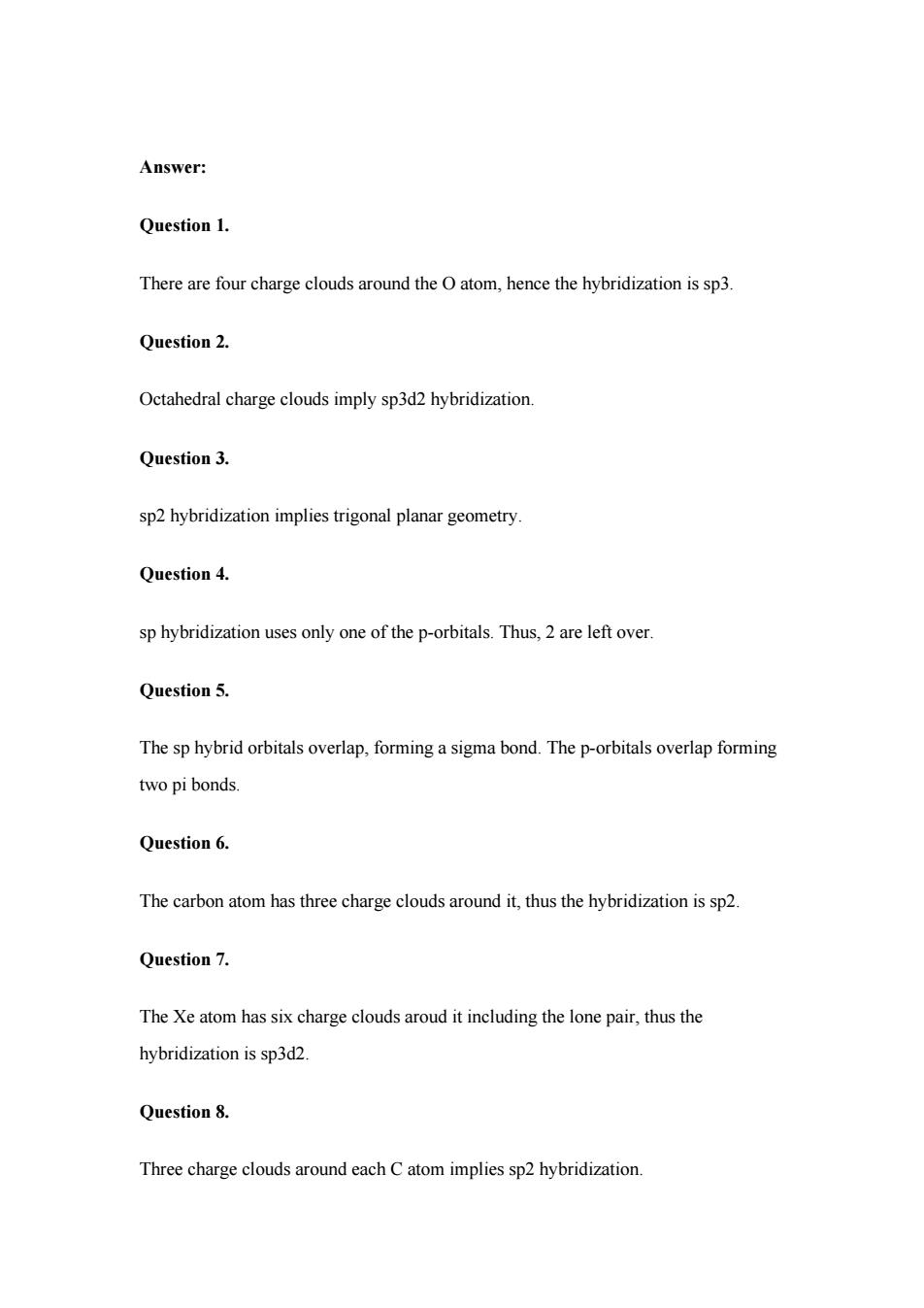
Answer: Question 1. There are four charge clouds around the Oatom,hence the hybridization is sp3 Question 2. Octahedral charge clouds imply sp3d2 hybridization. Question3. sp2 hybridization implies trigonal planar geometry. Question 4. sp hybridization uses only one of the p-orbitals.Thus,2 are left over. Question 5. The sp hybrid orbitals overlap,forming a sigma bond.The p-orbitals overlap forming two pi bonds. Question 6. The carbon atom has three charge clouds around it,thus the hybridization is sp2. Question 7. The Xe atom has six charge clouds aroud it including the lone pair,thus the hybridization is sp3d2. Question 8. Three charge clouds around each Catom implies sp2 hybridization
Answer: Question 1. There are four charge clouds around the O atom, hence the hybridization is sp3. Question 2. Octahedral charge clouds imply sp3d2 hybridization. Question 3. sp2 hybridization implies trigonal planar geometry. Question 4. sp hybridization uses only one of the p-orbitals. Thus, 2 are left over. Question 5. The sp hybrid orbitals overlap, forming a sigma bond. The p-orbitals overlap forming two pi bonds. Question 6. The carbon atom has three charge clouds around it, thus the hybridization is sp2. Question 7. The Xe atom has six charge clouds aroud it including the lone pair, thus the hybridization is sp3d2. Question 8. Three charge clouds around each C atom implies sp2 hybridization
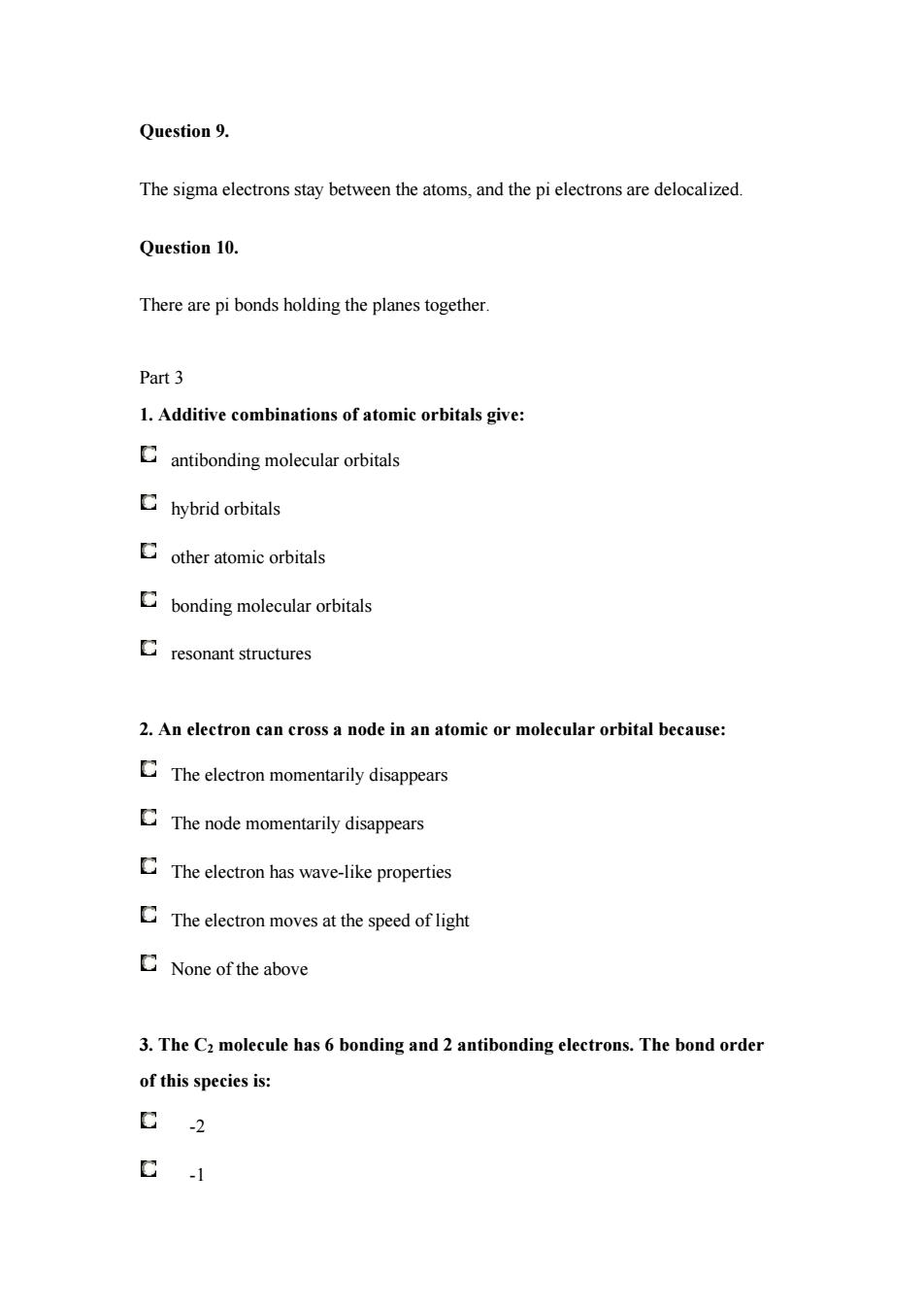
Question 9. The sigma electrons stay between the atoms,and the pi electrons are delocalized. Question 10. There are pi bonds holding the planes together Part3 1.Additive combinations of atomic orbitals give: antibonding oritals hybrid orbitals other atomic orbitals bonding obitals resonant structures 2.An electron can cross a node in an atomic or molecular orbital because: The eltro mmetarily disappears The node momentarily disappears The electron has wave-like properties The electron moves at the speed of light CNone of the above 3.The C2 molecule has 6 bonding and 2 antibonding electrons.The bond order of this species is: 0-2 01
Question 9. The sigma electrons stay between the atoms, and the pi electrons are delocalized. Question 10. There are pi bonds holding the planes together. Part 3 1. Additive combinations of atomic orbitals give: antibonding molecular orbitals hybrid orbitals other atomic orbitals bonding molecular orbitals resonant structures 2. An electron can cross a node in an atomic or molecular orbital because: The electron momentarily disappears The node momentarily disappears The electron has wave-like properties The electron moves at the speed of light None of the above 3. The C2 molecule has 6 bonding and 2 antibonding electrons. The bond order of this species is: -2 -1